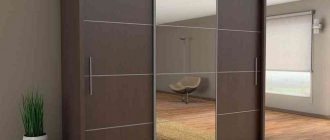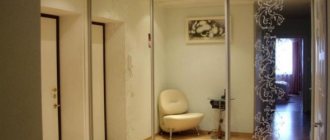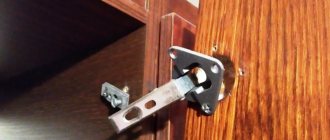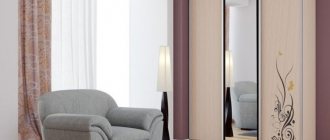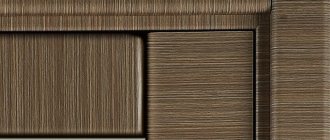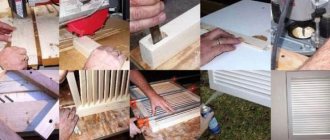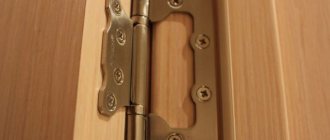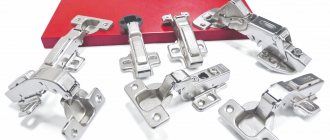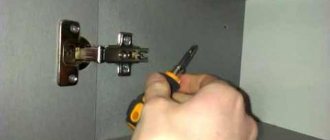Carrying out renovations in a home that will be a refuge for you and your family for many years to come is a natural and useful activity, especially if done in a timely manner, but it also takes a lot of effort.
Sometimes even such a simple task as unsticking a mirror from a cabinet can become overwhelming if you don’t know the special secrets that professional builders have developed over many years.
Mirrors are usually glued tightly to cabinets, or screwed using fastening devices. But their shape can get boring, and over time they become damaged. Let's learn how to remove them by learning several techniques for separating mirrors from the surface of the cabinet.
How to remove a mirror from a closet door?
Separation of mirrors held on its surface by fasteners from the cabinet
So, first of all, we will discuss how to remove mirrors from the cabinet that are mounted on its surface using fastening systems.
When separating the mirror from the surface of the cabinet, it would be wise to remove the door from its hinges and lay it horizontally so that the glass does not fall to the floor haphazardly
Table 1. Mounting systems for mirrors
| Fasteners | Description |
| Suckers | Silicone suction cup holders are not often used as a fastening device for placing a mirror on a vertical cabinet surface, however, they are still found. In this case, you are more likely to worry about the suction cups not accidentally coming off if the door of a given piece of furniture slams too loudly, since silicone suction cups are too often poorly made. Consequently, they are unable to hold the mirror in the place you have determined, and this accessory often falls. How to remove: You can easily remove a mirror fixed to the surface of the cabinet door using suction cups by simply gently pulling its body. If the suction cup does not come off easily, carefully pick up its edge with a ruler or fingernail. |
| Screws | Quite often, mirrors are attached to cabinet doors, walls and other vertical surfaces using screws. Screws can hold this accessory to the surface of the cabinet, while being passed through: mirror frame; "body" of the mirror surface. In both cases, the screws do not stick out on the surface; they are hidden under special rivets made in the shape of a mushroom: with a wide hat; with a leg that fits inside the groove of the mirror screw. How to remove: All you need to do to remove a mirror mounted on screws is to pick up the decorative knob of the fastener, remove it, and then, using the most ordinary screwdriver that fits the size, unscrew one by one all the screws that hold the mirror. Please note: to remove the mirror without breaking it, you need the help of a second person to hold the accessory, preventing it from falling. |
| Staples | Bracket holders are another way to secure a mirror to a cabinet door. Each holder is separately screwed into the wall using flat-head screws. Before screwing it in, a bracket is put on each screw - a holder, which will then hold the mirror. The tighter the bracket is tightened, the stronger the mirror “sits” in it. Several such staples are used along the entire perimeter of the mirror to clearly fix our mirror accessory. How to remove: And depending on the quality and thickness of the staples, as well as your desire to use them in the future, the following methods can be used to remove the mirror from the surface of the cabinet: bending the staples with pliers (in this case it will be impossible to reuse them); unscrewing screws. Please note: in this case, you will also have to enlist outside help, since when the brackets are sequentially unscrewed, the mirror will no longer hold anything, and someone must do it with their hands. |
The above methods of attaching a mirror involve the use of special fasteners, which are initially designed in such a way that you can get rid of them as simply as possible by easily removing them from the mounting location, and along with them the mirror itself.
Such fasteners are called reusable. Indeed, if you do not accidentally or deliberately damage them while removing the mirror, they can then be used in tandem with it, while placing the piece of furniture on a different surface. We recommend that you use just such fasteners, since they are the easiest to remove, even without any specialized experience or sophisticated construction tools. To rid your closet of a mirror with each of them, the maximum you will need is:
- assistant;
- screwdriver;
- time.
Reusable fastening systems for mirrors, of course, are much more convenient, since they allow you to quickly remove the reflective surface, and then use both it and the fasteners themselves more than once.
However, preliminary fastening of mirrors to other construction devices can create a serious problem. Let's look at them in the next section.
All types and properties
There are two types of glue: neoprene and acrylic. Neoprene has a strong chemical smell (contains rubber), but has good adhesion to surfaces. Acrylic – environmentally friendly, harmless. But it is water soluble, so it is not used in bathrooms. Exposure to high temperatures is also unacceptable.
Among the neoprene series, QUELYD Mastifix - it reliably glues even heavy mirrors without damaging their reverse side. Can be used on bathroom walls.
There is acrylic LACRYSIL “Super strong fixation” intended for exterior and interior use. Bonds all building materials to any building surface.
IRFix mirror adhesive :
Rubber GROVER is designed for mounting heavy structures and mirrors. Suitable for interior and exterior work.
Is it possible to peel off an extra decorative element yourself?
The answer is clear: yes. But for beginners, the process is quite labor-intensive and requires high concentration and careful attention, so it is better to arrange for yourself an environment in which nothing can distract you.
If you follow all the rules, follow safety precautions and follow the recommendations, you can remove the mirror at home in half an hour or less , but in cases of difficulties or complex fasteners, it is better to contact specialists with experience in such work with this issue.
Tips and step-by-step guide on how to peel a mirror off a cabinet door yourself
Sometimes things happen that make a mirror on a closet, for one reason or another, need to be removed and replaced to avoid trouble. If a chip has formed on it, hopelessly spoiling the appearance, or a crack, it is better not to keep such a thing in the house and try to replace it with a new one as soon as possible.
In such a situation, your mirror not only spoils the appearance of the interior, but also becomes a direct threat to the residents, especially if there are small children in the house who are fond of active games. You can get rid of a cabinet decor element that has become superfluous in several ways, depending on the fastening, and the main tool is you and your hands. Our article is about how to peel off a mirror from a cabinet, remove it from a wall, or separate it from a wardrobe door if it was glued with liquid nails, double-sided tape or other glue.
If you do everything correctly, you will easily cope and will not spend a day waiting for a specialist and, most importantly, money.
Wardrobe design
First, a few words about the design of the wardrobe. Since they are of different types, we will look at the design of a two-door wardrobe made of chipboard. So, the cabinet consists of the following assembly units:
- Basement,
- frame,
- Rear wall,
- Doors,
- Shelves,
- Fastening and guiding elements.
The door, in turn, consists of:
- door leaf,
- Vertical profile,
- horizontal profile,
- Top guide,
- Bottom guide,
- Lower rollers,
- upper rollers,
- Assembly screws,
- Adjustment screws,
- Seals,
- Stubs.
To repair a wardrobe door, you need to determine the type of damage and assess whether you can fix it yourself.
What tools will you need?
To safely peel off the mirror you will need the following set of tools:
- construction hair dryer (can be replaced with a household hair dryer, but with an increase in heating period);
- metal ruler or copper wire;
- regular or double-sided tape;
- stationery knife;
- screwdriver figured or flat.
In fact, the set of tools is small. Thanks to it, you can remove the door from the cabinet and start working with the mirror element. Even if the closet has mirrors with an area of more than 2 square meters, you can make do with improvised means by zoning the work in advance. This is the first thing you need to do before learning how to peel a mirror off a cabinet door.
If the mirror is attached with a special fastener system, then dismantling is simple, but if the mirror is held on by “liquid nails” or special glue, then the task is much more difficult.
Safety regulations
Since it is quite difficult to peel off a mirror, and the procedure itself is not safe, it is important to follow the following safety rules:
- clothing should completely cover the entire body, and the elastic bands on the sleeves and legs should fit snugly to the body;
- Be sure to use glasses (it is better if it is a full-size face shield);
- all work is carried out in an open space, preferably not indoors;
- when working, it is necessary to exclude the presence of children;
- After work, wet cleaning is carried out several times;
- Hands are washed with soap more than 2-3 times to completely wash off all glass microparticles.
Although dismantling a mirror is considered a simple process, it is dangerous, because the mirror can burst at any moment, flying into pieces.
Note! Automotive hand cleaning paste is the best solution for washing your hands if your mirror is cracked or has visible defects.
What is the best way to disconnect?
- The first method is suitable for cabinets from which the door can be removed. Do not remove the mirror when it is in a vertical position, as you may break it and injure yourself.
- For the second method, you will need wire, and it works like this: with movements to the left and right, you need to cut off both the layer of liquid nails and other adhesive mass that attaches your mirror to the cabinet. This option is very convenient and the safest: nothing will burst or crack if you do not overdo it with sharp movements.
- The third method is intended for a wardrobe, when working with which it is especially recommended to be more careful and adjust the level of brute force if the mirror is not to be damaged.
How to peel off a mirror from a cabinet if it is attached to it using construction substances
In this case, construction substances will be understood as disposable fasteners, represented by condensed liquids that have pronounced fastening properties.
So, we are talking, of course, about:
- double-sided tape (tape on which a layer of adhesive is applied);
- liquid nails (special construction adhesive, especially strong when hardened, which is used for mounting various parts, and in particular, installing a mirror);
- construction adhesive specifically used for working with specific surfaces.
Using liquid adhesives as a way to secure the mirror to the surface of the cabinet, you must understand that removing the mirror will most likely break it into many pieces
Removing a mirror from a closet door without damaging the mirror and also without getting hurt is very difficult if you don’t know specific tricks that will at least help you protect yourself. The fact is that when the required substances mentioned above are used, subsequently the mirror turns out to be tightly fixed and it is really very difficult to separate it without breaking it.
Let's sum it up
Removing a mirror is an incredibly labor-intensive process, since mirrors are usually attached to cabinets so that they hang in a specific place for them even after the cabinet itself fails. It would be good if reusable fasteners were used to install the reflective surface, however, as a rule, we are talking about the use of adhesive construction substances that make easy removal of the mirror from its current location impossible. Please read the instructions we have provided above carefully. At least one of them must be suitable in your case. Then you can peel the mirror off the cabinet and place a newer model in its place.
Video - The process of removing a mirror from a cabinet door
How to Remove a Mirror from a Closet Door: Step-by-Step Guide
The most common case is defined as the removal of a part from a furniture accessory. All that is needed is indicated above in the article. So let's get straight to the simple steps:
- As in the previous method, you need to cover the front side with tape to fix the position.
- Next, without applying much effort, you should place a small part of the screwdriver under the edge.
- At the end of the process, it is worth eliminating the particles that remain from the glue and getting rid of contaminants.
How to remove a mirror from a cabinet that is well glued with double-sided tape, so as not to damage it?
I’ll write how I did it, although you might think that the double-sided tape was a temporary phenomenon, but the mirror could not be torn off and there was a danger that it would simply break.
I glued it to the tape without sparing, not only along the edge, but also in the middle and boldly.
So it was impossible to get under with a spatula or a utility knife; ordinary wire came to the rescue, which was in an electric corrugation for pulling the wire inside.
I cut off a piece of about a meter and began to peel it off from the top using sawing movements, then, having reached about the middle, I started from the bottom, and in about twenty minutes I disconnected the mirror from the door.
I removed the tape from the door itself, not paying attention to the fact that I might damage something, just with a plastic spatula, but from the mirror I carefully had to remove it piece by piece with a hair dryer, so as not to damage the mirror coating.
This is how I removed it, by the way, I removed it, trivially, so that later I could simply hang it higher, again gluing it with double-sided tape.
www.remotvet.ru
How to cut or tear off a mirror panel glued with double-sided tape from a door?
Double-sided tape does not seem as impressive as liquid nails, but this is not entirely true, because the mirror can be glued to it not only in the middle and along the edges, but also over the entire area. If desired, the mirror can be torn away from its mounting location, but there is a high risk of breaking the thing and injuring your hands with large fragments, so it is better to discard this method immediately and not try to use it under any circumstances.
A good way to remove a mirror from double-sided tape is similar to the one described above using cutting wire. If you don’t have an item for exactly this purpose, you can take a strong string or any thin but strong wire that will pass between the mirror and the door and will not break during the sawing process.
Recommendations
- If the mirror holder is glued to the glass with epoxy glue (rubber), this glue is simply heated and the coin is gradually torn off from the glass. If the penny is held on by glass glue, in this case the adhesive base is cut off with a string.
- Before removing the rear view mirror, it is important to make sure that various devices and elements are not connected to it: cameras, video recorders, parking sensors, light and temperature sensors in the cabin, etc. Errors during dismantling can lead to breakdowns and malfunctions of such devices.
How to remove marks on the wall after dismantling?
Once the mirror has been removed, you can begin to peel off the old adhesive layer . You can do this in the usual way, using a spatula or knife, if this place then covers the mirror again. To preserve the surface and not scratch it, you can use the second option: here the main assistant is gasoline or solvent.
The solution with dissolution is more successful if there is information about the composition of the glue. You need to apply a solvent to the surface of the cabinet and wait until it softens the glue and allows it to be wiped off. You can stick a new mirror onto the cleaned area, but this must be done carefully so as not to break it.
Features of mirrors
Thanks to their reflective properties, mirrors can visually expand the space, add light to the room, and hide its imperfections. Enclosed in beautiful frames with built-in lighting, clock mechanisms, ornaments, drawings or inscriptions, they perform a decorative function and can also be part of the decoration.
The expected effect is reduced to zero if flaws appear on the mirror surface. This often happens due to improper care, because despite its apparent strength, the mirror is a rather fragile material. Of course, it will not be possible to completely eliminate the defects, but you can try to mask the scratches on the surface yourself.
ATTENTION!
To extend the life of the mirror, it is necessary to provide it with high-quality care. Do not use sharp objects, hard sponges or abrasive cleaners for cleaning and washing. For bathrooms, it is better to purchase special mirrors designed for rooms with high humidity, where the coating is protected from destruction by moisture.
What to watch out for
When working with chemical compounds, certain rules must be followed, otherwise unpleasant situations cannot be avoided. When working, the following precautions are taken into account:
- It is prohibited to heat the glue container;
- When working, refrain from smoking, as fumes can easily ignite;
- there must be constant air access to the room where sizing is performed;
- Use personal protective equipment whenever possible;
- Do not allow glue to get into eyes or skin;
- It is prohibited to give cylinders to children.
How to remove?
Before you begin removing double-sided tape, you must carefully read the instructions and removal tips, because any careless movement can ruin the surface on which traces of the tape are located.
There are dozens, maybe hundreds of methods for removing adhesive marks, but the most effective ones are revealed below. Let's look at each of them in more detail.
Stationery knife
The method is simple, but it is permissible to use it if the likelihood of scratching the surface is minimal . Proceed with caution.
The paper or film base is pryed off with a blade. The loose edge of the tape can be easily torn off by hand.
If it was not possible to remove all the adhesive tape at once, and pieces remain, you need to lift the edge of the adhesive tape again with the tip of a knife, and so on until it is completely removed.
Rubber (caoutchouc) disc
A soft attachment for a drill or screwdriver will help you cut off adhesive tape from a large area . The rubber disc will remove the top sticky layer without leaving scratches on the surface.
The tool must be set to minimum speed. Plastic rubber will not harm even the paintwork.
Glue heated to 80-100°C is removed faster. You can use either a hair dryer or a hair dryer to dry your hair. They can be replaced with an iron set to the minimum temperature.
The advantage of this method is the absence of scratches even on paper . The most tightly attached tape can be removed without difficulty.
But there is no need to heat non-heat-resistant objects to high temperatures, especially with a powerful hair dryer - they will immediately deform. It is better to expose them to the sun for a short time or keep them under steam - the glue will noticeably soften.
Oil
The glue will easily slide off if you lubricate the area of contamination with vegetable or essential (for example, eucalyptus) oil . They contain organic unsaturated acids that can dilute polymers:
Wipe the sticky surface with a sponge and leave for several hours.- You can lay a rag soaked in oil on a horizontal tabletop or bedside table for about 20 minutes.
- If the stain is stubborn, it is best to leave the greased stain on overnight. In the morning the stain will come off without effort.
- All that remains is to wash off the oil. Easy to clean surfaces (glass, polished furniture, plastic) do not absorb grease, so there will be no problems.
This method is not acceptable for paper wallpaper.
Eraser
If you rub the remaining glue with a regular eraser, it will form pellets and come off easily . Just rub it with a cloth.
Gasoline, acetone, white spirit
The main advantage of the method is the ease and speed of removal:
It is necessary to moisten a rag in any of the existing types of solvents and rub the stain.
The type of surface should be taken into account. Regular gasoline can leave behind greasy stains.
It is better to replace it with a highly purified composition, for example, liquid intended for refilling Zippo lighters.
Acetone easily dissolves paint and varnish, so it is not recommended to use it for cleaning furniture. The same goes for removing stains on wallpaper. White spirit is used to treat any type of surface, with the exception of those painted with unstable dyes.
Glass cleaning liquid
Most of them are made with alcohol, which is an excellent solvent.:
- You need to rub the stain with a sponge or rag soaked in this mixture, and after a couple of minutes there will be no trace of the sticky stain.
- You can replace the windshield wiper with regular drinking alcohol or ammonia. They can even cope with dried out, old stains.
- More serious products are car glass cleaners. But it should be noted that, in addition to alcohol, they contain quite strong chemicals and ammonia.
Table vinegar or citric acid
Any acid can dissolve glue . In everyday life, vinegar or lemon is more often used.
You should rub the contaminated area with citric acid soaked in table vinegar or diluted water, and the dirt will easily come off.
This method has a significant advantage: the acid does not leave streaks . The smell of vinegar will disappear in just half an hour.
General Tips
For those who often face the need to remove glue residues, we can give several useful recommendations:
when gluing tape to a painted surface, you need to be prepared for the fact that this area will lighten a little over time;- fresh traces of glue are much easier to remove than old ones;
- Solvent 646, in addition to ethers and alcohols, contains acetone; this mixture will cope with any type of glue;
- There are special products on sale for removing adhesive tape, for example, Label Remover; you need to look for them in construction stores;
- Fire starter fluid will also help remove remaining adhesive tape; however, it is only able to dissolve certain types of glue;
- You can replace acetone with a more gentle composition - nail polish remover.
